Citation: Neufeld, K., Watkinson, D, and M.S. Poesch. 2017. COSEWIC status report on the Western Silvery Minnow (Hybognathus argyritis). Ottawa, Ontario, pp 46.
Note: once published, copyright is owned by COSEWIC.
Freshwater fishes are among the most imperiled groups globally with rates of decline comparable to declines in tropical rainforest species. Research in the PoeschLab focuses on developing a better understanding of the mechanisms for the decline of freshwater organisms. This research has four main themes, including: 1) threats to freshwater species at risk, 2) stream augmentation and hydrologic alteration, 3) climate change impacts to freshwater fishes, and 4) the spread and impact of invasive species. To achieve our research goals we utilize a variety of expertise in the PoeschLab and the University of Alberta. This includes expertise in: movement ecology and telemetry, assessing foodwebs using stable isotope analysis, population genetics and environmental DNA (eDNA) and morphology and swim performance.
Citation: Neufeld, K., Watkinson, D, and M.S. Poesch. 2017. COSEWIC status report on the Western Silvery Minnow (Hybognathus argyritis). Ottawa, Ontario, pp 46.
Note: once published, copyright is owned by COSEWIC.
Abstract:
Prussian carp (Carassius gibelio) are one of the most noxious non-native species in Eurasia. Recently, Prussian carp, a nonnative freshwater fish species, were genetically confirmed in Alberta, Canada and have been rapidly expanding their range in North America since establishment. Given their rapid range expansion, there is an increasing need to determine how Prussian carp may impact native species. We assessed the severity of the Prussian carp invasion by (i) determining their impact on fish communities, (ii) assessing their impact on benthic invertebrate communities, (iii) evaluating if Prussian carp alter abiotic conditions, and (iv) identifying where we find higher abundances of Prussian carp. When Prussian carp were established, we found significant changes to the fish community. Correspondingly, the degree of impact to benthic invertebrate communities was related to the stage of invasion (none, early or recent), where changes in fish communities were significantly concordant with changes in benthic invertebrate communities. Finally, we found that higher abundances of Prussian carp were significantly associated with lower abundances of a majority of native fish species. Altogether, using three lines of evidence, we determine that Prussian carp can have wide-ranging impacts on freshwater ecosystems in North America, pressing the need for management intervention.
Citation: Ruppert, J.L.W.*, Docherty,C.*, Rudolfsen, T.*, Neufeld, K.*, Hamilton, K.*, MacPherson, L. and M.S. Poesch. (2017) Native North American freshwater species get out of the way: Prussian Carp (Carassius gibelio) establishment impacts both fish and macroinvertebrate communities. Royal Society Open Science 4: 170400.
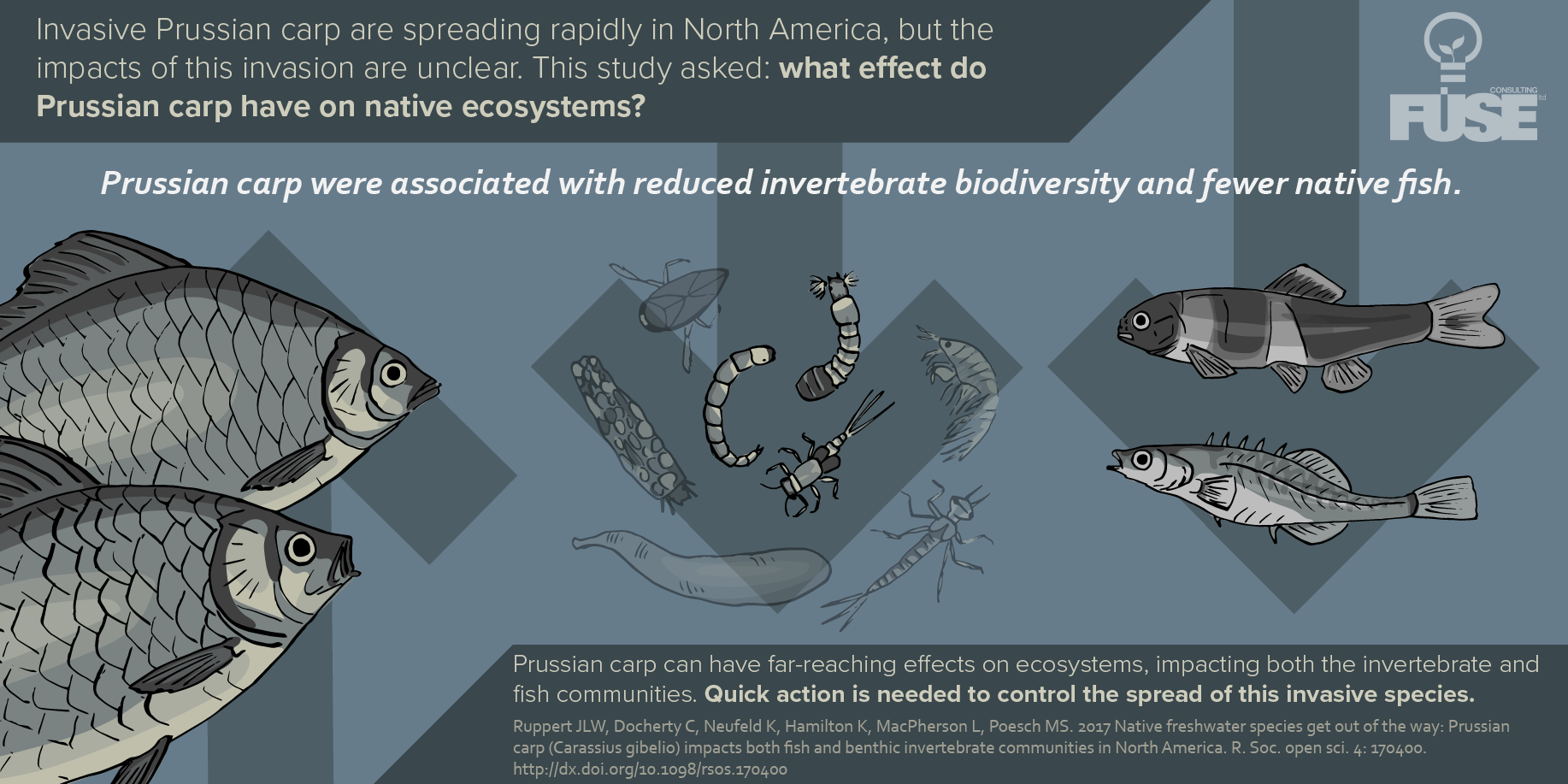
Also Read:
*Lab members: Jonathan Ruppert, Cassandra Docherty, Tyana Rudolfsen, Kenton Neufeld, Kyle Hamilton, Mark Poesch. Check out opportunities in the lab!
Abstract:
Prussian Carp (Carassius gibelio Bloch, 1782) is one of the most successful invasive species in Eurasia. Recently, Prussian Carp were genetically confirmed in Alberta, Canada, documenting the first detection of this species in North America. Given the close morphological similarity to their sister species, the Goldfish (Carassius auratus Linnaeus, 1758), it is likely that this species has been undetected for some time. We document the spread of Prussian Carp since arrival (circa 2000), and contribute a trait-based risk assessment to potential recipient communities in western North America. Using a meta-analysis of geo-referenced fisheries data in conjunction with original sampling in 2014, we show that the Prussian Carp range has increased by eight- to eleven-fold over 15 years in Alberta at a rate of approximately 233–1,250 km2 per year. Range expansions in the near future are possible through the Saskatchewan River drainage and south into the Missouri River basin, with easily accessible routes to Midwestern North America through irrigation canals. We show high life history trait overlap with other successful invasive species, such as Goldfish and Common Carp (Cyprinus carpio Linnaeus, 1758). Additionally, there was high life history trait overlap with several species of native sunfish (Centrarchidae) and suckers (Catostomidae). This study highlights Prussian Carp’s potential to widely impact North American freshwater ecosystems and to successfully compete with native taxa. Considered one of the worst invaders in Eurasia, the arrival of Prussian Carp in North America poses serious concern for fisheries managers. There is an urgent need to develop management plans before further range expansion and disruption of freshwater ecosystems by this new invasive species.
Citation: Docherty, C.*, Ruppert, J.*, Rudolfsen, T.*, Hamann, A., and Poesch, M.S. 2017. Assessing the spread and potential impact of Prussian Carp (Carassius gibelio Bloch, 1782) to freshwater fishes in western North America. BioInvasions Records 6: 291-296.
Spread of Prussian Carp in Alberta, Canada
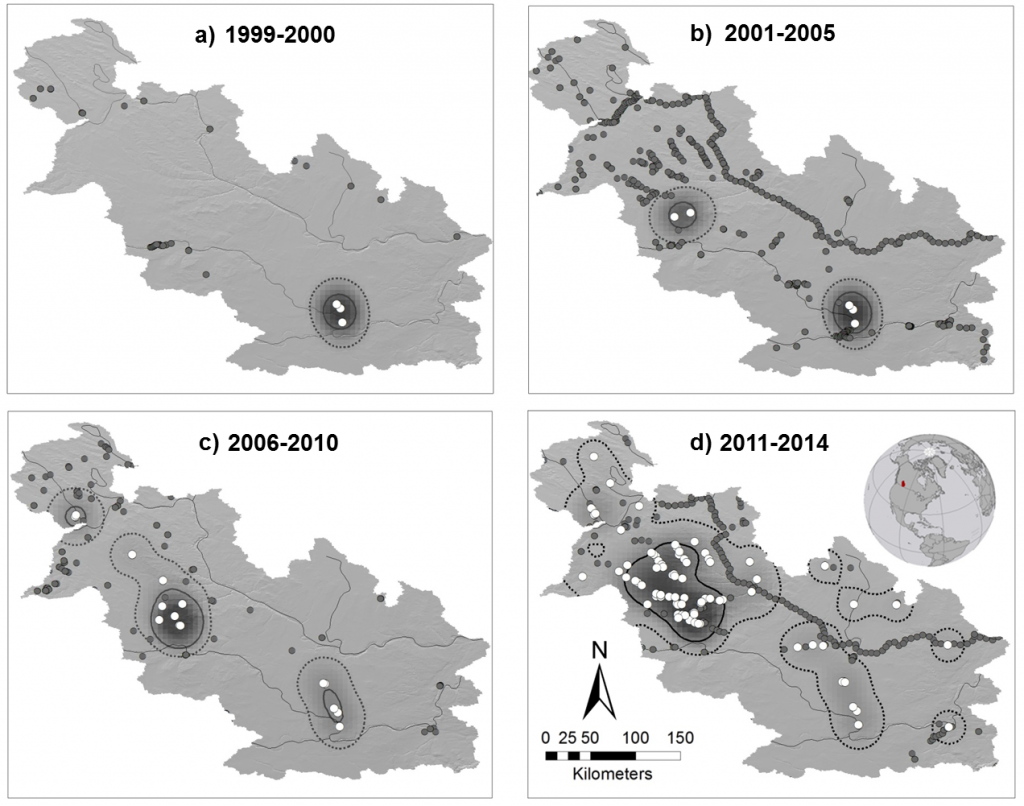
Also Read:
*Lab members: Cassandra Docherty, Jonathan Ruppert, Tyana Rudolfsen, Mark Poesch. Check out opportunities in the lab!
Abstract:
Hydrologic alterations, such as dams, culverts or diversions, can introduce new selection pressures on freshwater fishes, where they are required to adapt to novel environmental conditions. Our study investigated how species adapt to natural and altered stream flow, where we use the threatened Rocky Mountain Sculpin (Cottus sp.) as a model organism. We compared the swimming and station-holding performance of Rocky Mountain Sculpin from four different hydrologic regimes in Alberta and British Columbia, including the North Milk River, a system that experiences increased flows from a large-scale diversion. We measured the slip (Uslip) and failure (Uburst) velocities over three constant acceleration test trials. Uslipwas defined as the point at which individuals required the addition of bursting or swimming to maintain position. Uburst was defined as the point at which individuals were unable to hold position in the swimming chamber through swimming, bursting or holding techniques without fully or partially resting on the electrified back plate. We found individuals from the Flathead River in British Columbia (with the highest natural flow) failed at significantly higher Uburstvelocities than fish from the southern Albertan populations. However, there was no relationship between peak hydrologic flow from the natal river and Uburst or Uslip. Further, Uburst velocities decreased from 51.8 cm s−1 (7.2 BL s−1) to 45.6 cm s−1 (6.3 BL s−1) by the third consecutive test suggesting the use of anaerobic metabolism. Uslip was not different between trials suggesting the use of aerobic metabolism in station-holding behaviours (Uslip). Moreover, we found no significant differences in individuals from the altered North Milk River system. Finally, individual caudal morphological characteristics were related to both slip and failure velocities. Our study contributes to the conservation of Rocky Mountain Sculpin by providing the first documentation of swimming and station-holding abilities of this benthic fish.
Citation: Veillard, M.F.*, Ruppert, J.L.W.*, Tierney, K., Watkinson, D., and Poesch, M.S. 2017. Comparative swimming and station-holding ability of the threatened Rocky Mountain Sculpin (Cottus sp.) from four hydrologically distinct rivers. Conservation Physiology 5: 1-12.
Difference in Swim Performance Across Populations of Rocky Mountain Sculpin. Shown are Tukey contrasts (estimate +/- 95% confidence intervals) between rivers (top row) and constant acceleration trial (CAT) numbers (bottom row) for failure (Uburst) and slip (Uslip) velocities from linear effects model. Significant differences are noted in yellow; Rivers are abbreviated as: Flathead River (FH), St. Mary River (SM), Lee Creek (LC) and North Milk River (NM).
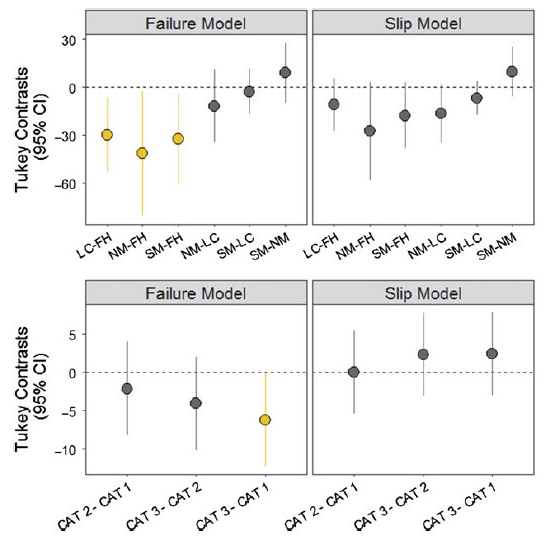
Also Read:
*Lab members: Marie Veillard, Jonathan Ruppert, Mark Poesch. Check out opportunities in the lab!
Abstract:
The relationship between species’ size and home range size has been well studied. In practice, home range may provide a good surrogate of broad spatial coverage needed for species conservation, however, many species can show restricted movement during critical life stages, such as breeding and over-wintering. This suggests the existence of either a behavioral or habitat mediated ‘temporal bottleneck,’ where restricted or sedentary movement can make populations more susceptible to harm during specific life stages. Here, we study over-winter movement and habitat use of Lake Sturgeon (Acipenser fulvescens), the largest freshwater fish in North America. We monitored over-winter movement of 86 fish using a hydro-acoustic receiver array in the South Saskatchewan River, Canada. Overall, 20 fish remained within our study system throughout the winter. Lake Sturgeon showed strong aggregation and sedentary movement over-winter, demonstrating a temporal bottleneck. Movement was highly restricted during ice-on periods (ranging from 0.9 km/day in November and April to 0.2 km/day in mid-November to mid-March), with Lake Sturgeon seeking deeper, slower pools. We also show that Lake Sturgeon have strong aggregation behavior, where distance to conspecifics decreased (from 575 to 313 m) in preparation for and during ice-on periods. Although the Lake Sturgeon we studied had access to 1100 kilometers of unfragmented riverine habitat, we show that during the over-winter period Lake Sturgeon utilized a single, deep pool (<0.1% of available habitat). The temporal discrepancy between mobile and sedentary behaviors in Lake Sturgeon suggest adaptive management is needed with more localized focus during periods of temporal bottlenecks, even for large-bodied species.
Citation: Thayer, D.*, Ruppert, J.L.W., Watkinson, D., Clayton, T. and M.S. Poesch. (2017) Identifying temporal bottlenecks for the conservation of large-bodied fishes: Lake Sturgeon (Acipenser fluvescens) show highly restricted movement and habitat-use overwinter. Global Ecology and Conservation 10: 194-205.
Monthly core (C) and range (R) extent kernel density maps for: A) November, B) December, C) January, D) February, E) March, and F) April. Black lines are core range (50% percentile), broken lines range (90th percentile) extent.
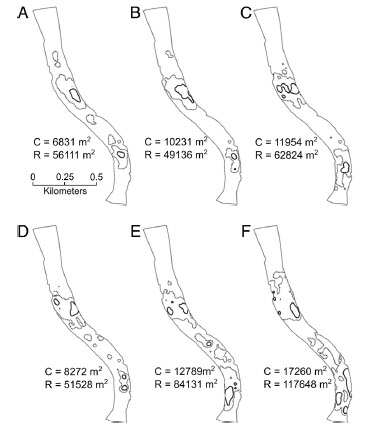
Also Read:
*Lab members: Donnette Thayer, Jonathan Ruppert, Mark Poesch. Check out opportunities in the lab!
Abstract:
Climate change is affecting many freshwater species, particularly fishes. Predictions of future climate change suggest large and deleterious effects on species with narrow dispersal abilities due to limited hydrological connectivity. In turn, this creates the potential for population isolation in thermally unsuitable habitats, leading to physiological stress, species declines or possible extirpation. The current extent of many freshwater fish species’ spatio-temporal distribution patterns and their sensitivity to thermal impacts from climate change − critical information for conservation planning − are often unknown. Carmine shiner (Notropis percobromus) is an ecologically important species listed as threatened or imperilled nationally (Canada) and regionally (South Dakota, United States) due to its restricted range and sensitivity to water quality and temperature. This research aimed to determine the current distribution and spatio-temporal variability in projected suitable habitat for Carmine shiner using niche-based modeling approaches (MaxEnt, BIOCLIM, and DOMAIN models). Statistically downscaled, bias-corrected Global Circulation Models (GCMs) data was used to model the distribution of Carmine shiner in central North America for the period of 2041–2060 (2050s). Maximum mean July temperature and temperature variability were the main factors in determining Carmine shiner distribution. Patterns of projected habitat change by the 2050s suggest the spatial extent of the current distribution of Carmine shiner would shift north, with > 50% of the current distribution changing with future projections based on two Representative Concentrations Pathways for CO2 emissions. Whereas the southern extent of the distribution would become unsuitable for Carmine shiner, suitable habitats are predicted to become available further north, if accessible. Importantly, the majority of habitat gains for Carmine shiner would be in areas currently inaccessible due to dispersal limitations, suggesting current populations may face an extinction debt within the next half century. These results provide evidence that Carmine shiner may be highly vulnerable to a warming climate and suggest that management actions – such as assisted migration – may be needed to mitigate impacts from climate change and ensure the long-term persistence of the species.
Citation: Pandit, S.N.*, Koriala, L., Maitland, B.M*, Poesch, M.S., and E. Enders. (2017) Climate change risks, extinction debt, and conservation implications for an endangered freshwater fish Carmine Shiner (Notropis percobromus). Science of the Total Environment 598: 1-11.
Predicted Change in Carmine Shiner Distribution given Climate Change Scenarios (RCP 2.6 top; RCP8.5 bottom) across various thresholds
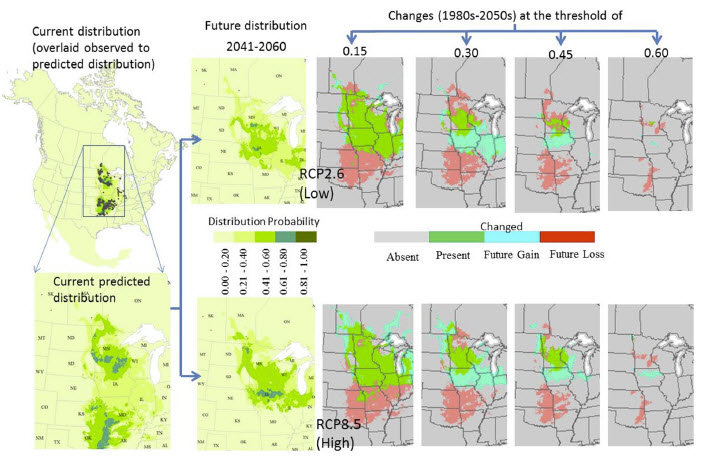
Also Read:
*Lab members: Shubha Pandit, Bryan Maitland, Mark Poesch. Check out opportunities in the lab!
Dr. Poesch’s paper on climate change impacts to freshwater fishes was featured in the Spring 2017 issue of Renew.
Link to pdf: Renew_Spring_2017
Link to paper on “Climate change impacts on freshwater fishes: A Canadian perspective“.
Abstract:
Understanding the movement ability and the spatial scale(s) of population genetic structure of species can together better ‘tune’ management objectives to prevent potential range contraction and population declines. We studied the Rocky Mountain Sculpin (Cottus sp.), a threatened species in Canada, to demonstrate the utility of using two complementary approaches to assess connectivity of a species. To do so, we used Passive Integrated Transponder (PIT) tags with a stationary tracking array (n = 223) to track movement and genetic data (n = 1,015) from nine microsatellite loci to assess genetic population structure. The PIT tag results indicated that Rocky Mountain Sculpin are sedentary; approximately 50% of individuals only moved a maximum distance of 10 meters (upstream or downstream) over a 5-month period. Genetic analyses indicated that at the spatial scale of our study area (5500 km2), watershed structure (river basins) is the main geographic feature influencing population genetic structure. We used the Bayesian clustering tool STRUCTURE, which suggested four distinct sub-populations of Rocky Mountain Sculpin in Canada. Genetic structure at finer spatial scales (within basins and sub-basins) appears to be influenced by fluvial distance (i.e., geographic distance along a river) and elevation change between sample locations (i.e., isolation-by-distance and isolation-by-environment). Combining movement and genetic analyses provides complimentary evidence of limited dispersal in Rocky Mountain Sculpin and highlights that both approaches together can provide broader insight into connectivity between populations that may ultimately help to aid future management decisions.
Citation: Ruppert, J.L.W.*, James, P.M.A., Taylor, R., Rudolfsen, T.*, Veillard, M.*, Davis, C., Watkinson, D. and Poesch, M.S. 2017. Riverscape genetic structure of a threatened and dispersal limited freshwater species, the Rocky Mountain Sculpin (Cottus sp.). Conservation Genetics 18: 925-937.
STRUCTURE results showing mean assignment of individuals into four clusters and sorted by geographic locatoins. Geographic locations are abbreviated as FH: Flathead River, LC: Lee Creek, STM: St Mary River and NM: North Milk River.
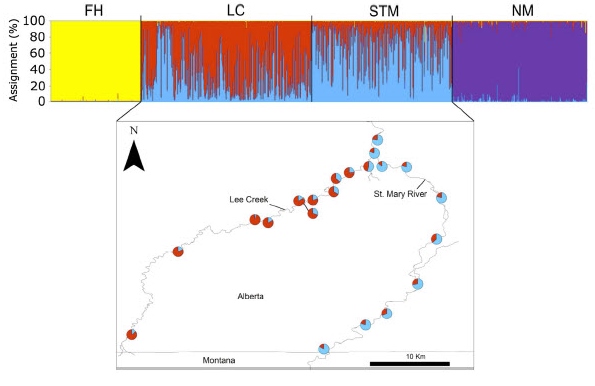
Also Read:
*Lab members: Jonathan Ruppert, Tyana Rudolfsen, Marie Veillard, Mark Poesch. Check out opportunities in the lab!
Abstract:
We developed a spatially explicit simulation model of poaching behaviour to quantify the relative influence of the intensity, frequency, and spatial distribution of poaching on metapopulation viability. We integrated our model of poaching with a stochastic, habitat-based, spatially explicit population model, applied it to examine the impact of poaching on northern abalone (Haliotis kamtschatkana) metapopulation dynamics in Barkley Sound, British Columbia, Canada, and quantified model sensitivity to input parameters. While demographic parameters remained important in predicting extinction probabilities for northern abalone, our simulations indicate that the odds of extinction are twice as high when populations are subjected to poaching. Viability was influenced by poaching variables that affect the total number of individuals removed. Of these, poaching mortality was the most influential in predicting metapopulation viability, with each 0.1 increase in mortality rate resulting in 22.6% increase in the odds of extinction. By contrast, the location and spatial correlation of events were less important predictors of viability. When data are limited, simulation models of poaching combined with sensitivity analyses can be useful in informing management strategies and future research directions.
Citation: Camaclang, A.E., Curtis, J.M.R., Poesch, M.S., and M.A. Koops. 2017. Modelling the impact of poaching on metapopulation viability for data-limited species. Canadian Journal of Fisheries and Aquatic Science 74: 894-906.
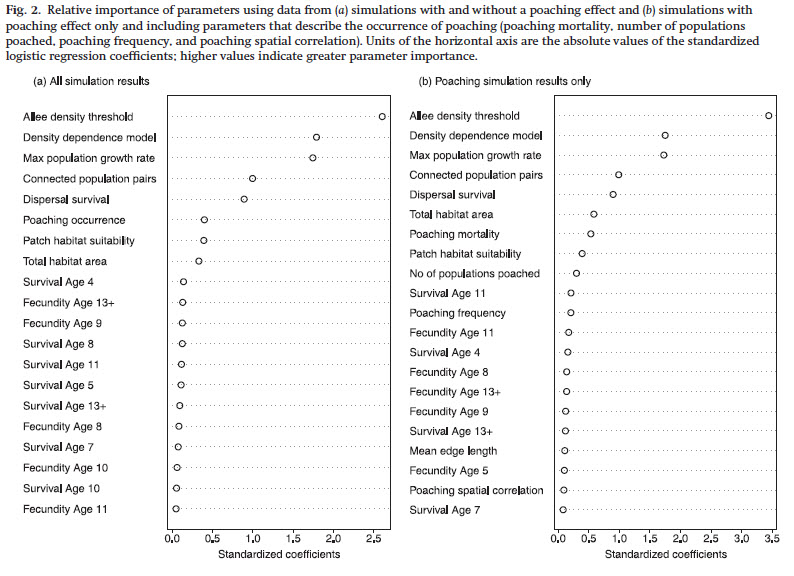
Also Read:
Abstract:
Stream crossing structures are an increasingly prevalent anthropogenic feature on North American riverscapes, particularly in watersheds affected by industrial resource development in sensitive boreal environments. If improperly managed, stream crossings have the potential to alter fish habitat and impede fish movement. This study assessed instream habitat characteristics and fish communities from 33 culverted, bridged and reference streams in an industrialising region of the boreal forest in west-central Alberta. Mixed-effects modelling and multivariate analysis were used to determine impacts of stream crossings at three scales: whole-stream scale, within-stream scale and the interaction of scales. Instream habitat characteristics such as mean depth, water velocity, percent fines, turbidity, water temperature and dissolved oxygen showed significant between-stream as well as within-stream differences among stream crossings. The majority of fish species exhibited significantly lower densities (n m−2) in upstream habitats as compared to downstream habitats, including a significant reduction in Slimy Sculpin densities in culverted streams. Multivariate tests corroborated these results, showing that fish assemblages differ as a function of stream type. This study suggests industrial stream crossings influence abiotic habitat characteristics in freshwater ecosystems, restrict biotic connectivity and impact fish community structure at the whole-stream and within-stream scales. Alterations to stream ecosystems associated with stream crossings may be driving large-scale changes in stream fish communities in the boreal forest. With expanded development expected in much of North America’s boreal region, mitigation measures which limit impacts from stream crossings are needed to ensure proper ecosystem function in freshwater systems.
Citation: Maitland, B.M.*, M.S. Poesch, Anderson, A.E., and S. Pandit*. (2016) Industrial road crossings drive changes in community structure and instream habitat for freshwater fishes in the Boreal forest. Freshwater Biology. 61: 1-18.
Figure – Barplot of fish community metrics of (a) fish density (number per m2) and (b) species richness across stream types and upstream and downstream locations (mean +/- SE). Sample sizes for stream types were: culvert (Cul) N = 11, bridge (Bri) N = 11, reference (Ref) = 11. Significant differences across stream types are identified by upper case letters, while significant differences between upstream and downstream reaches are identified by lower case letters.
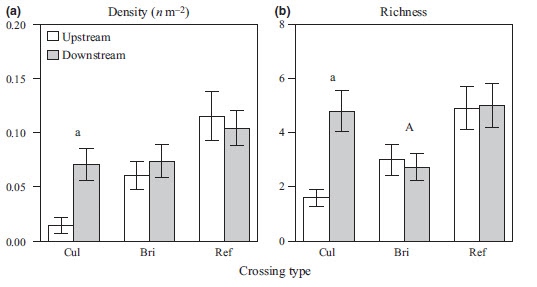
Also Read:
*Lab members: Bryan Maitland, Shubha Pandit, Mark Poesch. Check out opportunities in the lab!